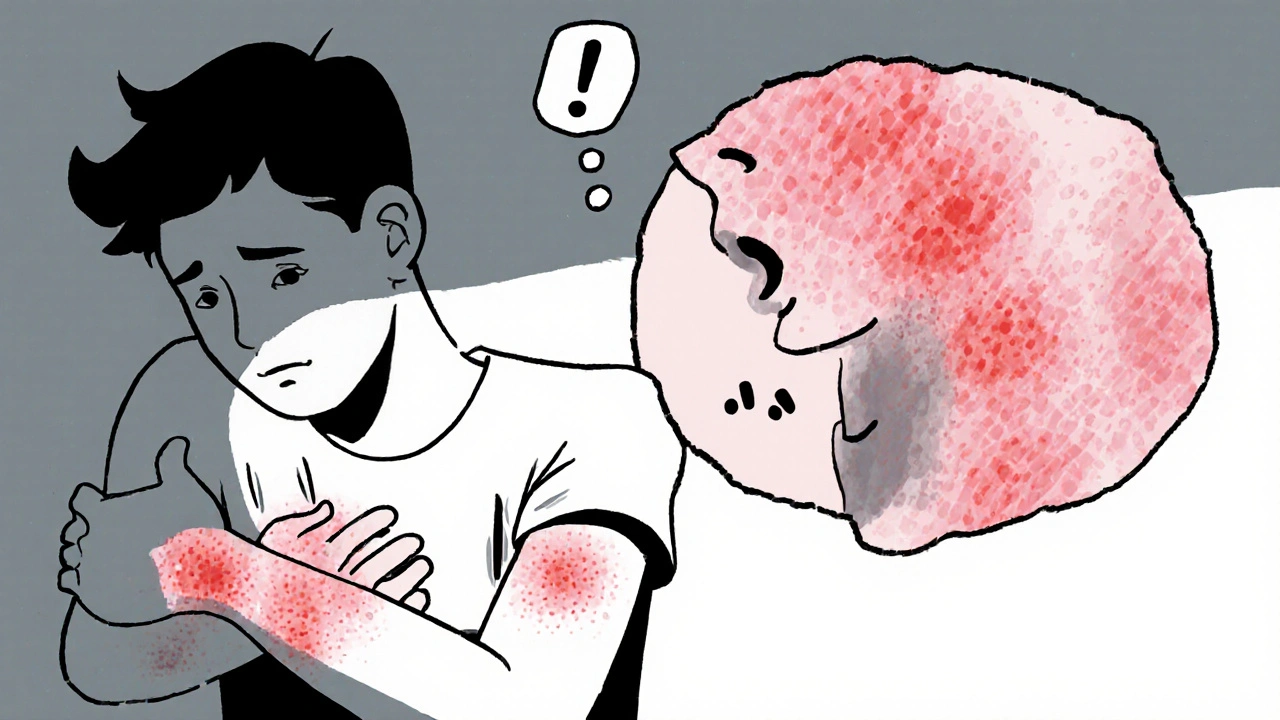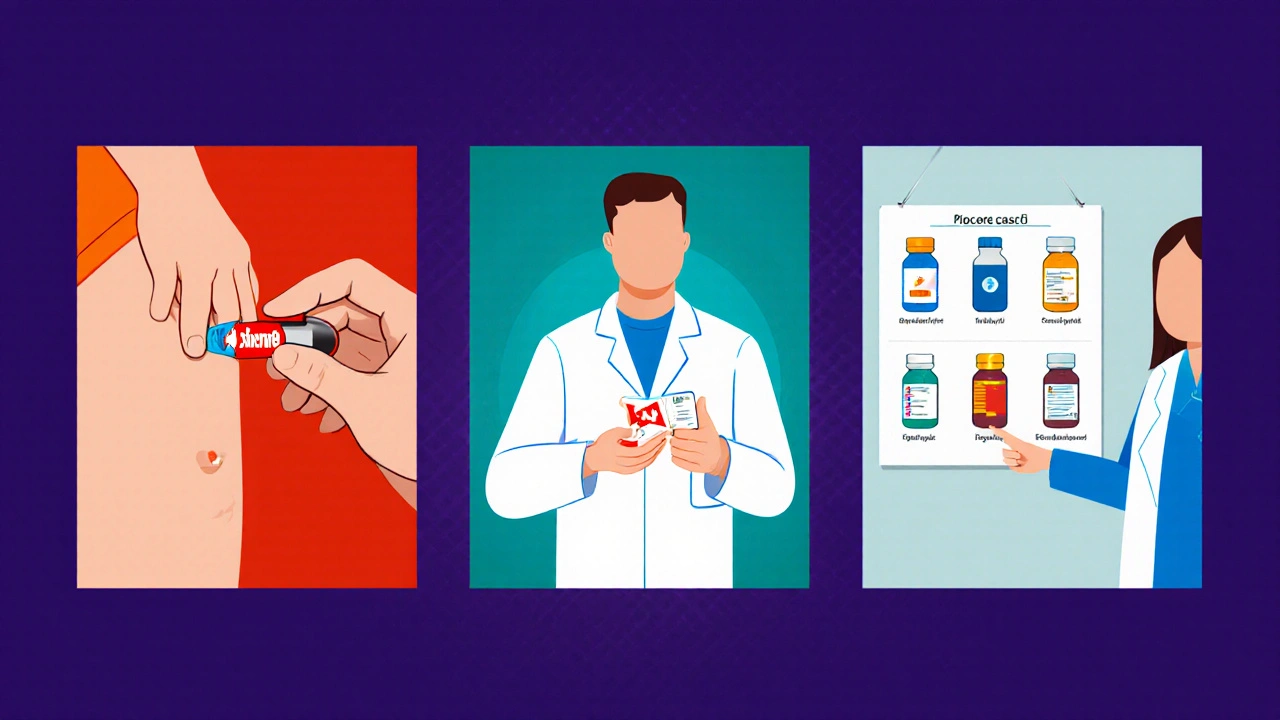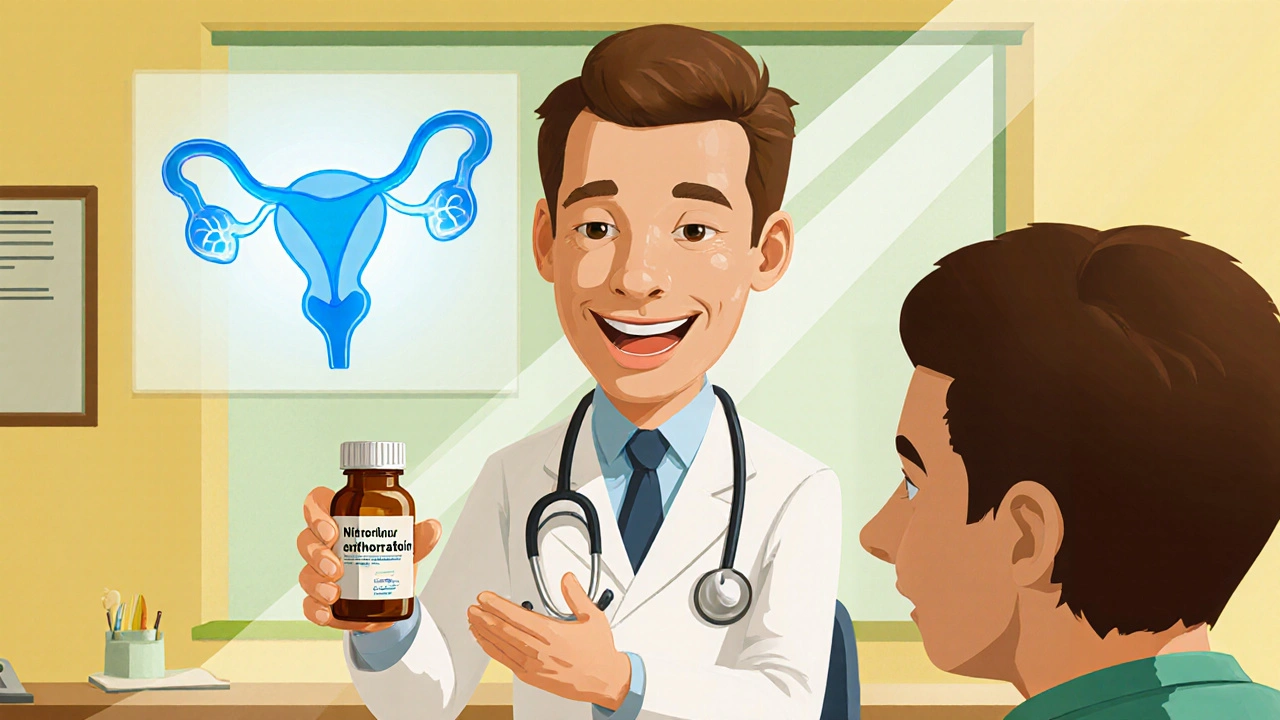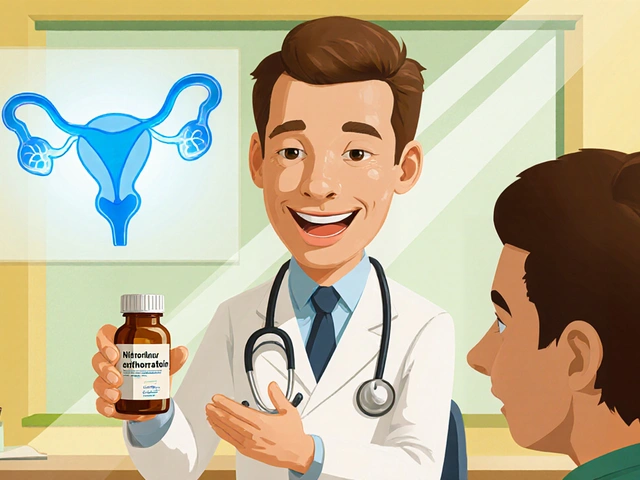Nitrofurantoin Allergy Symptom Checker
Check for Allergic Reaction
Select symptoms you're experiencing. This tool doesn't diagnose but helps identify potential allergic reactions.
When a doctor prescribes an antibiotic for a urinary tract infection, Nitrofurantoin is a synthetic nitrofuran‑class drug that concentrates in the bladder to kill common bacteria. For most people it works without a hitch, but a small‑to‑moderate group can develop a reaction that feels anything but ordinary. This guide walks you through how to spot a Nitrofurantoin allergy, what to do when symptoms appear, and which treatment paths keep you safe.
What Is Nitrofurantoin?
Nitrofurantoin was first approved by the FDA in 1953 and quickly became a go‑to oral therapy for uncomplicated lower urinary tract infections (UTIs). Its chemical formula, C8H6N4O5, gives it a unique ability to penetrate the urinary tract and release reactive metabolites that dismantle bacterial DNA. Because it stays mostly inside the urine, systemic exposure is low, which is why doctors often favor it over broader‑spectrum agents that can affect gut flora.
Typical dosing for adults is 50‑100 mg twice daily for 5‑7 days. The drug is eliminated primarily through the kidneys, so patients with severe renal impairment (creatinine clearance < 30 mL/min) are usually steered away from it.
Understanding Nitrofurantoin Allergy
Allergy isn’t the same as a simple side effect. A true allergic reaction involves the immune system mistaking the drug (or one of its metabolites) for a harmful invader and launching an antibody‑mediated response. This can happen after a single dose or after repeated exposures, and the severity can range from mild skin irritation to life‑threatening anaphylaxis.
Drug allergy is generally classified into two categories:
- IgE‑mediated (immediate) reactions: These occur within minutes to an hour and can include hives, swelling, wheezing, or a drop in blood pressure.
- Delayed hypersensitivity: Symptoms emerge after several hours or days and often involve rash, fever, or organ‑specific inflammation.
Because nitrofurantoin is a relatively small molecule, it usually needs to bind to a larger protein to become immunogenic. Once that happens, the body can remember the culprit and react faster on subsequent courses.
Common Symptoms of an Allergy
Knowing what to look for can prevent a mild reaction from spiraling into a medical emergency. Below is a practical checklist organized by system:
- Skin: Red, itchy hives (urticaria), widespread rash, or blister‑like lesions (Stevens‑Johnson‑like presentation).
- Respiratory: Tight feeling in the throat, wheezing, shortness of breath, or hoarseness.
- Cardiovascular: Rapid heartbeat, dizziness, fainting, or a sudden drop in blood pressure (shock).
- Gastrointestinal: Nausea, vomiting, abdominal cramping, or diarrhea that appears shortly after taking the drug.
- Systemic: Fever, chills, joint pain, or generalized malaise that isn’t typical for a UTI.
If any of these signs appear within 30 minutes of the dose, treat it as a potential emergency.

When to Seek Immediate Care
Not every rash means an allergy, but certain red‑flag symptoms demand urgent attention:
- Swelling of the face, lips, tongue, or throat (angioedema).
- Difficulty breathing, wheezing, or a high‑pitched whistling sound when exhaling.
- Sudden drop in blood pressure causing light‑headedness or fainting.
- Rapid spread of a blistering rash accompanied by fever.
Call emergency services (911 in the U.S.) or head to the nearest emergency department. Bring the medication bottle with you-knowing the exact formulation (macrocrystalline vs. extended‑release) helps clinicians choose the right antidotes.
Treatment Options
The primary goal is to stop the immune attack while managing any lingering infection. Here’s a step‑by‑step roadmap most clinicians follow:
- Discontinue Nitrofurantoin Immediately: Stopping exposure halts the source of the antigen.
- Administer Antihistamines: Over‑the‑counter H1 blockers (diphenhydramine, cetirizine) reduce hives and itching. For severe cases, an H2 blocker (ranitidine) may be added.
- Consider Corticosteroids: A short taper of oral prednisone (e.g., 40 mg daily for 3‑5 days) dampens a delayed hypersensitivity response.
- Use Epinephrine for Anaphylaxis: Auto‑injectors (0.3 mg intramuscular) are life‑saving. If you have a known severe reaction, carry one at all times.
- Switch to an Alternative Antibiotic: Choose an agent effective against the original uropathogen. Options include trimethoprim‑sulfamethoxazole, fosfomycin, or a fluoroquinolone (reserved for resistant cases).
Below is a quick comparison of the most common alternatives:
| Drug | Typical Use | Pros | Cons / Cautions |
|---|---|---|---|
| Trimethoprim‑Sulfamethoxazole (TMP‑SMX) | Uncomplicated UTI, some skin infections | Broad spectrum, inexpensive | Can cause sulfa allergy, renal dosing needed |
| Fosfomycin (single‑dose) | Single‑dose treatment for uncomplicated UTI | Convenient, low resistance rates | May be pricey, not for pyelonephritis |
| Levofloxacin (fluoroquinolone) | Complicated UTIs or when resistance is suspected | Excellent tissue penetration | Risk of tendon rupture, QT prolongation, needs reservation |
| Ceftriaxone (IV) | Severe infections needing hospital care | Well‑tolerated, once‑daily dosing | Intravenous only, possible C. difficile risk |
Choosing the right substitute depends on the bacterial culture results, kidney function, and any other drug allergies you might have. Always discuss the plan with your prescriber.

Preventing Future Reactions
Allergy documentation is a cornerstone of safe prescribing. Here are practical steps to keep you protected:
- Update Your Medical Records: Add “Nitrofurantoin allergy - type (immediate or delayed)” in your electronic health record and on any personal medication list.
- Carry an Allergy Card or Bracelet: A simple paper card that lists the drug and reaction type can alert emergency staff.
- Avoid Cross‑Reactivity: Although nitrofuran drugs are few, inform providers that you reacted to nitrofurantoin before they prescribe nitrofurazone or furazolidone.
- Consult an Allergist: Skin‑prick testing or in‑vitro IgE assays can confirm the allergy and assess risk for related antibiotics.
- Stay Informed: New guidelines (e.g., 2024 CDC update on UTI management) may shift first‑line therapy away from nitrofurantoin for certain populations.
By keeping the information current, you reduce the chance of a repeat exposure and help clinicians choose the safest alternative.
Frequently Asked Questions
Can I develop an allergy to nitrofurantoin after taking it for years without problems?
Yes. Allergic sensitization can occur after any number of exposures. Some patients develop a reaction only after a recent course, even if they tolerated the drug for years before.
Is a mild rash always an allergic reaction?
Not necessarily. Nitrofurantoin can cause a non‑allergic side effect called a phototoxic rash, especially after sun exposure. Distinguishing between the two often requires a clinician’s assessment or allergy testing.
Do I need to stop the antibiotic if I only have a mild headache?
Headache alone isn’t a typical allergic sign. However, if the headache is accompanied by any skin or respiratory changes, you should discontinue and call your provider.
How long does it take for symptoms to resolve after stopping nitrofurantoin?
Mild skin reactions often improve within 24‑48 hours once the drug is cleared. More severe reactions, like eosinophilic pneumonia, may take weeks and require steroids.
Can I be desensitized to nitrofurantoin if it’s the only effective drug for my infection?
Desensitization is rare for nitrofurantoin because safer alternatives exist. In exceptional cases, an allergist might perform a graded challenge under close monitoring.
Understanding the signs, acting quickly, and working with your healthcare team are the best ways to stay safe while treating a urinary infection. If you suspect an allergy, trust your instincts and get evaluated-better safe than sorry.



Comments
As any seasoned pharmacologist will attest, nitrofurantoin's pharmacokinetic profile is well‑characterized and seldom warrants alarm. The drug’s renal excretion ensures minimal systemic exposure, which is why the majority of patients tolerate it without incident. Yet you seem to overlook the nuances of IgE‑mediated hypersensitivity that have been documented since the 1970s. In short, the allergy spectrum is neither novel nor mysterious, and any credible discussion should reference the primary literature rather than anecdotal blog posts.
Hey, you’ve got this! If you suspect an allergy, stop the med immediately and seek medical help – no need to play doctor at home. Call your provider, get an epinephrine auto‑injector if you’ve ever had a reaction, and keep a detailed symptom log for your next appointment. This isn’t a game; allergic responses can escalate within minutes, so act fast and stay calm.
Look, I’ve actually had a rash from nitrofurantoin twice, and I didn’t even tell anyone because I thought it was just a harmless skin thing. Turns out, the doctor told me it was a delayed hypersensitivity and switched me to fosfomycin. So, next time you feel a weird itch, trust your gut and don’t wait for the rash to spread.
Honestly this whole nitrofurantoin thing feels like a soap opera in my bloodstream . You think a pill is harmless and then bam a rash appears like a plot twist . My heart races, my throat feels tight, and I’m left wondering who’s the villain . It’s outrageous how quickly a simple UTI medication can turn into a life‑changing drama .
The article does a decent job outlining the basic signs of nitrofurantoin allergy, but it glosses over the epidemiological data that would contextualize risk. For instance, incidence rates vary significantly across demographics, and the piece fails to mention the renal function thresholds that dictate contraindication. Moreover, the treatment algorithm is overly simplistic; it does not address the role of corticosteroid tapering protocols in delayed hypersensitivity. A more rigorous citation of peer‑reviewed studies would greatly enhance credibility.